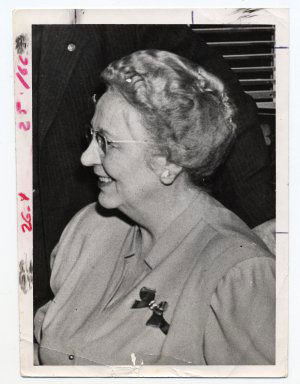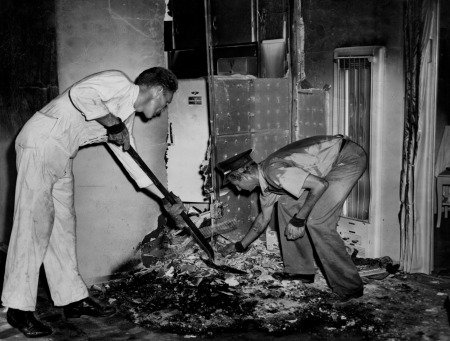1951, July 1: Mary Reeser’s Fiery Death

Mary Reeser. [Picture sources here]
The last time 67-year-old widow Mrs. Mary Reeser was seen alive was on July 1, 1951. Her son, Dr. Richard Reeser, and her landlady, Mrs. Pansy M. Carpenter, both said goodnight at about 9:00PM and left Mrs. Reeser sitting in her easy chair in her apartment in St. Petersburg, Florida.
The first sign of trouble was at 5:00AM. Mrs. Carpenter was awakened by the smell of smoke and, assuming it was a water pump in the garage that had been overheating, she turned the pump off and went back to sleep.
At 8:00AM, Mrs. Carpenter was awakened by a telegraph boy at her door; he had a telegraph for Mrs. Reeser. Carpenter signed for the missive, and walked to Mrs. Reeser's room... but there was no answer to her knock. Carpenter checked the doorknob; it was hot! Alarmed, Carpenter ran outside to find some help. A pair of house painters working nearby rushed over to her aid, and, together, they managed to force open the door to Mrs. Reeser's apartment only to be met by a terrible blast of heat, evidence of a fire within. What was discovered inside the room defied belief.
The only portion of the apartment that was burned was the small corner in which sat the remains of Mary Reeser's easy chair... and of Mary Reeser herself. Of the chair, only charred coil springs remained. Of Mrs. Reeser, there was little more; and these remains baffled the firemen, police, and pathologists that examined them.
Mrs. Reeser's 170 pounds had been reduced to less than ten pounds of charred material. Only her left foot remained intact, still wearing a slipper, burnt off at the ankle but otherwise undamaged. Also found were her liver, now fused to a lump of vertebrae, and, stranger still, her skull... strangely shrunk to the size of a teacup.
The remainder of the apartment showed all the signs of heat damage; from about the four foot level on up, the walls were covered with a greasy soot, a mirror had cracked, plastic switches and a plastic tumbler in the bathroom had melted, as had two candles on a dresser which left behind their unburned wicks and a pink pool of wax. Below the four foot level, the only damage was the small circular burn area encompassing the remains of Mrs. Reeser and her chair, and a plastic electric wall outlet that had melted, stopping her clock at 4:20AM.
What could have burned Mrs. Reeser so fiercely without causing more damage to her surroundings? Experts pointed out that a temperature of 2500 degrees is necessary for such a thorough cremation; and that cigarette igniting her clothing would never have produced that temperature. The electrical outlet had melted only after the fire had begun, so couldn't be the source. An FBI pathologist tested a carpet sample for gasoline and other accelerants; there were none. Even lighting had been considered, but there had been none in St. Petersburg that night.
Months after the occurrence, the Chief of Police and the Chief of Detectives signed a statement attributing the fiery death of Mary Reeser to falling asleep with a cigarette in her hand. Although already shown to be an impossibility, the declaration served to publicly close the investigation.
New Theories and One Continuing Question
Since the day that the investigation into Mary Reeser's death was closed, forensic medicine has made leaps forward, and especially in the specialized field of death by fire. A large number of unusual fire deaths with features similar to Reeser's are now considered explainable.
 Fire officials examining Reeser's remains. [Picture sources here]
Fire officials examining Reeser's remains. [Picture sources here]
The main details that confounded experts previously were: the complete destruction of the victim's torso (most fire victims have their limbs destroyed, but leave a charred torso because it's larger), the localized nature of the fire and its direct damage, and the victim's apparent lack of the ability to escape or call for help. These features were once theorized to mean that the victim was destroyed more or less instantly, and that the fire must have started within their bodies... a situation known as Spontaneous Human Combustion, and something not publically believed to exist by fire officials.
It has since been demonstrated that an very intense fire, such as in a crematorium, is not the only way to destroyed a torso and bone tissue; a small smoldering fire can have a very intense localized heat that is capable of destroying a human body, as long as it has time to act. This is now known as the "Wick Effect," and happens when a small fire is started on a victim's clothing (Reeser was smoking when last seen) which then causes the fat in their bodies to break down and burn, using their clothing like the wick of a candle. A chair like the "overstuffed" one that Reeser was sitting in is capable of a smoldering burn as well... so it could have also have created a slow but intense flame that would have gradually consumed Reeser's body. Given several hours, such a fire could reduce Reeser's body to mere ash. Her foot remained undamaged because it was stretched out away from her -- her leg had hurt, remember -- and so was not in the area of the smoldering chair and clothing. All of this assumes, of course, that the victim was incapable of escaping or responding. So before the fire began Reeser was already dead or incapcitated... but we know she had taken sleeping pills before her son left, so this could explain a lack of response. Once a fire got started, she may have suffocated shortly after.
There is, however, one detail that is not explained by the Wick Effect, a detail that is very peculiar to the Reeser case and a point of controversy. Her shrunken skull.
On July 5, 1951, Coroner Ed Silk, who had performed the examination of Reeser remains, released them for burial. Newspapers quoted his summary of the remains as ashes, one lower leg, some fused vertebrae, and her skull somehow reduced to the size of a teacup. Heads don’t shrink when exposed to heat, they expand... and, in extreme temperatures, they explode. There is no known process that causes bone to decrease in size; shrunken heads produced in some cultures around the world start by removing the victim's skulls, then proceed to shrink the skin of the head; skulls don't shrink. So how could Mrs. Reeser's skull shrank?
The shrunken skull represents a possibly paranormal feature to an otherwise explanable case; so, not surprisingly, many theories have been proposed to try to explain away this detail. The most popular thought on the matter is that the shrunken skull was not in fact Reeser's skull, it was a charred knot of muscle from the back of her neck that had formed a hard ball and been mistaken for bone. This theory also presumes that Ed Silk, a professional coroner, didn't know what he was looking at... which is hard to believe, but possible. Unfortunately, only Ed Silk ever examined the 'skull,' so we have to take his word for it; the remains, even if they were still miraculously in good enough shape for a second examination, were buried and cannot be recovered without the permission of Reeser's existing family.
Anomalies -- the Strange & Unexplained, as well as my other website -- Monsters Here & There -- are supported by patrons, people like you! All new Anomalies articles are now posted for my patrons only, along with exclusive content made just for them. You can become a patron for just $1 a month!
|








